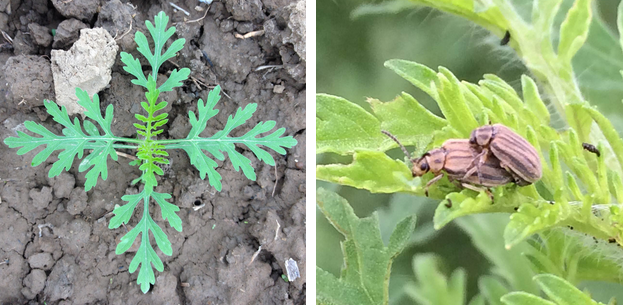A new progress in the evolutionary mechanism of defence against herbivores in invasive plants has been made by Prof. Shaolin Peng’s team in School of Life Sciences
Source: School of Life Sciences
Written by: Zhou Ting
Edited by: Wang Dongmei
Recently, Journal of Ecology, an international academic journal of ecology, published “Re-association of an invasive plant with its specialist herbivore provides a test of the Shifting Defence Hypothesis”, which is the latest scientific research made by Prof. Shaolin Peng’s team in School of Life Sciences at Sun Yat-sen University. The study reveals the evolutionary mechanism of defence against herbivores in invasive plants after re-association with their native specialist herbivores. The first author of the paper is Jinlong Wan, a PhD student (2013), and the corresponding author is Prof. Shaolin Peng. The study was supported by the National Natural Science Foundation of China and the Science and Technology Planning Project of Guangzhou.

Ambrosia artemisiifolia Ophraella communa
The shifting defence hypothesis (SDH) has been recognized as one of major reasons of invasion of exotic plants. It predicts that after invasive plants are introduced to new ranges, they will evolve reduced resistance to specialist herbivores and increased resistance to generalist herbivores because they can escape from specialists but are still attacked by generalists in their non-native ranges. For this to be true, the subsequent introduction of native specialist herbivores should reverse the above evolutionary processes, but evidence collected so far is scarce. Prof. Shaolin Peng’s team found that the invasive plant Ambrosia artemisiifolia evolved increased resistance to specialist herbivores and reduced resistance to generalist herbivores in the introduced range (China) after re-association with a specialist leaf beetle Ophraella communa from the native range (North America). They also found these evolutionary processes might be mediated by the reduced production of some important defensive secondary chemicals. This study supports the SDH from a new viewpoint, and enriches the theory of the invasion ecology, providing new insight about the future evaluation of the long-term control effects of classical biological control programs.
Link: https://besjournals.onlinelibrary.wiley.com/doi/abs/10.1111/1365-2745.13019
